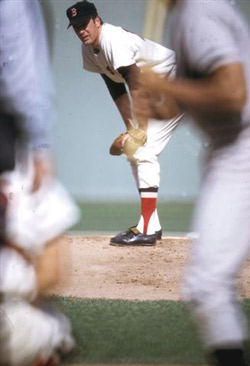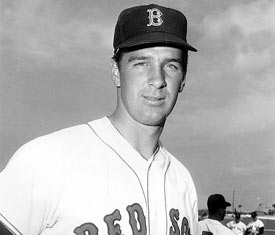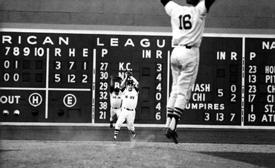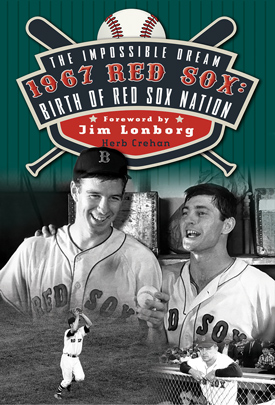
It has been more than fifty-years since the 1967 Boston Red Sox captivated New England and built the foundation of Red Sox Nation but Jim Lonborg’s clutch pitching down the stretch lives on in the memories of Red Sox fans.
Former Red Sox pitcher Jim Lonborg pitched one of the most important games in the history of Fenway Park on the last day of the 1967 season. A win over the Minnesota Twins guaranteed the team at least a tie for the American League Pennant but a loss would bring their storybook season to a close. The particular challenge of pitching at Fenway Park played a big role in “Gentleman Jim’s” pre-game routine.
“In 1967 I had pitched better on the road [13 wins] than I had at Fenway [8 wins to that date],” Jim Lonborg recalled recently from his home in Scituate, MA. “When Ken Harrelson offered me his room at the Sheraton Boston so I could get a good night’s sleep before the game, I jumped at the chance. I figured if I treated it like a road game, staying in a hotel, eating from room service, and walking to the ballpark, it might give me an edge. It worked out pretty well.”
Worked out pretty well is a very large understatement. Lonborg held the Twins to three runs over nine innings and executed a perfect bunt to jump-start a five- run Red Sox sixth inning, His 22nd win placed him atop the league in that category and gave the Red Sox their first American League Pennant in 21 years. Overjoyed Red Sox fans celebrated the 5-3 victory by carrying Jim Lonborg around the field on their shoulders.
KIWANIS RED SOX
Jim Lonborg grew up in San Luis Obispo, California, more than 3,000 miles from Fenway Park, but he may have been fated to play for the Red Sox. “In 1950 they organized the Little League in my town and my team was the Kiwanis Red Sox,” Jim remembers. “When we won the championship our coach, Stub Sweeney, wrote to the Red Sox and they sent autographed pictures for each of our players as a reward. My picture was signed to me from Mel Parnell [Red Sox All-Star pitcher from 1947-1956]. It was a big thrill for a little kid and I still have that picture.”
When Jim Lonborg enrolled at Stanford University in 1960 as a pre-med major, a career in professional baseball wasn’t even on his radar screen. But a stellar season in the Basin League—the west’s counterpart of the Cape Cod League—attracted the interest of baseball scouts. Lonborg signed with the Red Sox for a modest bonus and reported to the Red Sox single-A franchise in Winston-Salem for the 1964 season.
Lonborg was so impressive at Winston-Salem that the Red Sox moved him all the way to their top farm club in Seattle at mid-season. He pitched well against more experienced players in Triple-A, and after an outstanding spring training in 1965, he was promoted to the big league club. After just one season in professional baseball, he was about to get his first look at Fenway Park.
Jim Lonborg’s first trip to Fenway Park is indelibly etched in his memory. “After spring training we came to Boston to get ready for Opening Day. We stayed at the old Kenmore Hotel and since I had never been to Boston, I had to ask the doorman for directions to Fenway Park.
“As I approached the park it didn’t look anything like any ballpark I had ever seen before,” he recalls. “I was from California and I had been to Dodger Stadium and Candlestick Park, which were newer parks, so Fenway looked very different to me.
“When I walked up the ramp from the concourse behind first base, the first thing I could see was the top of the Green Monster,” he says. “And as you continue up the ramp the wall gets bigger and bigger. It’s quite an imposing sight, especially for a pitcher. The first thing I did when I got on the field was to pace off the distance down the line to see exactly how far the wall was from home plate.”
The Comforts of Home
During his seven seasons pitching for the Red Sox, exactly one-half of Jim Lonborg’s 68 pitching victories came in Fenway Park and one-half came on the road. Despite this even split, he acknowledges that pitching in front of the hometown fans has its advantages.
“You make about half of your starts at home so you are very familiar with the surroundings and quirks of the ballpark,” he says. “The mound is more comfortable and the support of the fans helps. When you pitch away from home you have to adjust to the different setting.”
Pitching at Fenway Park is a battle for pitchers Lonborg agrees, but the leftfield wall is not quite the monster it is made out to be. “Pitching in Fenway you always have to be aware of the Green Monster, but over the long-haul, for every fly ball that just makes it over the wall, there will be a hard line drive that hits halfway up and the batter ends up with a long single. Over time it tends to even out.”
But Fenway’s unique dimensions pose other challenges for pitchers. “Only in Fenway will you watch a ball get by the right fielder and roll along the curve in the wall, or rattle around in the triangle in right-center field while the center fielder tries to chase it down. It can be pretty frustrating standing on the mound watching your outfielders trying to cope with the idiosyncrasies of Fenway Park.”
For Jim Lonborg’s first two seasons with the Red Sox in 1965 and 1966, the team drew an average of fewer than 10,000 fans per game. Asked if that was disheartening for players, he says, “Not really, because we knew that the fans that turned out were avid fans.
“And you could look around and have a sense of what was going on in the stands,” he says. “I remember that about once a month it would be “Nuns Day.” You could look up into the stands and see a couple of hundred nuns in their habits enjoying the game.”

The Impossible Dream Season
In 1967, the home opener against Chicago was postponed due to inclement weather and only 8,324 fans showed up the next day to watch Jim Lonborg defeat the White Sox 5-4. As the season progressed and the Red Sox emerged as pennant contenders, the team captured the imagination of New England and attendance surged. The 1967 Boston Red Sox drew 1,727,823 fans to Fenway Park, the most in the team’s history at that time.
Jim Lonborg agrees that an energized fan base played a part in the team’s success. “We had begun to believe in ourselves as a team and the fan’s support really helped. Everything came together that year. But when you step out on the mound you put yourself in a zone of 60’6”—you concentrate on that zone and you tune everything else out.”
Fenway’s field, specifically the infield grass, became a focus of the pitching staff that season. “A number of us on the pitching staff had a lot of sink on our pitches, and we induced a lot of ground balls. The infield grass seemed short to us and we went to the grounds crew and asked them to let the grass grow a little higher. They [the grounds crew] did, and it helped slow down grounders and give our infielders a better shot at the ball.
“Well, pretty soon our own hitters noticed what was going on,” Lonborg laughs. “And since there are more hitters than pitchers on a team they were able to convince the grounds crew to cut the grass back. But we did get them to put down more water in front of home plate, and that helped some.”

GAME 162 VS. TWINS
After a disappointing two-inning outing against the Cleveland Indians on September 27, 1967, Jim was ready for the ball in the crucial final game against the Twins. “It took me a little while to find my rhythm, and the Twins jumped out to a 2-0 lead, but after I settled into my groove, I knew I could hold them.”
Hold them he did, but the Twins were hanging tough, and when Lonborg led off the home half of the sixth inning, the Red Sox still trailed 2-0. Ever the thinking-man, he noticed that third baseman Cesar Tovar was playing back. Lonborg dropped down a surprise bunt and legged out a base hit that keyed a five-run Red Sox uprising.
“I had made up my mind standing in the on-deck circle that I was going to drop a bunt down. I knew Tovar was back and I thought the element of surprise might work for me. And I could run pretty well at that time.”
The Twins countered with a run in the eighth, to make it 5-3, but there was no way that Lonborg was going to relinquish the lead. With two down in the ninth, and close to 35,000 Fenway Faithful on their feet in anticipation, he jammed Rich Rollins with a fastball, and Rico waited anxiously for the harmless popup to settle in his glove.
“When I look at that picture of the last out, I think about how fortunate I was. That could never happen today. First of all, there would be a relief pitcher standing on the mound. And with the playoff format coming into play in 1969, it has been almost 50 years since you could win the pennant outright on the last day of the season. And finally, you couldn’t let 10,000 people out on the field to celebrate the way they did that day. That crowd was purely spontaneous, filled with good will, and delirious with joy. I will never forget that moment.
“At one point I looked around and realized I was the only player left on the field. And the crowd was carrying me out towards right field away from our dugout. But a couple of Boston’s ‘finest’ came to my aid and spirited me back to the clubhouse. What a memory that is!”

1967 WORLD SERIES
On October 4, 1967, Fenway Park was the scene of Game One of the World Series between the Boston Red Sox and the St. Louis Cardinals. Jim Lonborg remembers the excitement and pomp, but he points out, “We didn’t even know whether we would be in the World Series until three days before. We hadn’t given it a thought and we were still focused on our big win on the last day of the regular season.”
He clearly remembers that Fenway was filled with celebrities and dignitaries, but it was a conversation with Dodgers’ pitcher, and future Hall-of-Fame member, Sandy Koufax that stands out for him. “I was talking with Sandy, who was with the NBC-TV crew, before my start in Game Two,” he recalls.
“He asked me about my pre-game warm-up routine and I told him I worked on each of my pitches and generally just tried to get loose. He suggested warming up by running through the Cardinal’s batting order and focusing on how I would pitch to each of their hitters. It worked so well that day that I used his approach for the rest of my career.”
After following Koufax’ advice, Jim Lonborg retired the first 18 Cardinal hitters he faced. Hopes for a perfect game were dashed when he walked Curt Flood with one out in the seventh inning, but he retired the next two batters easily and he entered the Cardinals’ eighth inning six outs away from pitching only the second no-hitter in World Series history.
When Cardinals’ second baseman Julian Javier broke the spell with a cleanly hit double with two outs in the eighth inning, the sellout crowd at Fenway rose as one to give Lonborg an extended ovation. Jim retired the final four St. Louis batters with ease and finished with a one-hit, 5-0 victory. It was clearly one of the most dominant Red Sox pitching performance in World Series history.

FENWAY PARK TODAY
Jim Lonborg and his lovely wife Rosemary are long-time residents of Scituate, MA, and they are frequent visitor to Fenway Park. Jim is a big fan of the renovations and improvements. “I am always struck by how excited the fans are to be at the game and at Fenway,” he says. “All of the changes have made it a great place for fans to watch the game. It’s just a wonderful environment.”
He agrees that the expanded Red Sox clubhouse is a big enhancement for today’s players. But he believes that the former cramped clubhouse of his day offered one advantage. “Our lockers were so close together that it was easy to carry on a conversation that included most of your teammates. We would sit around after the game and talk about what happened and talk about the next game. The close quarters really encouraged that,” he emphasizes.
Jim Lonborg notes that while the park has been expanded and totally remodeled, the playing area hasn’t changed at all. “They have left the playing field alone and that is a good thing,” he points out. “I can sit with a grandson or a nephew at the game and point out a spot where something happened 45 years ago, and it hasn’t changed at all. That’s nice.”
On the last day of the 1967 regular season, Jim Lonborg achieved one of the great victories in the history of Fenway Park, helping to clinch the last American League Pennant won by the Boston Red Sox during the regular season. And Lonborg was the last Red Sox player we will ever see paraded around Fenway Park surrounded by 5,000 adoring fans.
Jim Lonborg is an integral part of the wonderful memories that Red Sox fans hold of Fenway Park. He helped to build the foundation that Red Sox Nation rests upon today!
 Portions of this article originally appeared in The Impossible Dream 1967 Red Sox: Birth of Red Sox Nation.
Portions of this article originally appeared in The Impossible Dream 1967 Red Sox: Birth of Red Sox Nation.
To order your copy of The Impossible Dream 1967 Red Sox: Birth of Red Sox Nation click here


Great memories! Gentleman Jim was awesome that year. Totally nasty. Then he tried to be Jean Claude Killy, got hurt and won six games in ’68. He didn’t become a steady contributing starter again until the 70’s with Milwaukee and Philly. All in a real solid guy who had a nice career. But who will ever forget ’67! 22-9, 246 Ks, Cy Young. Thanks for the nice article!
I remember Lonborg and the sixty seven Red Sox. After the Red Sox won We stood around waiting for the Dtroit angel score at Kenmore SQ
It wa s quite a party when we saw that the Red Sox were American league Champs.
That’s a great memory! Thanks for sharing.
great piece, love the memories !!
A good man. Nice article.
I have ordered the book. Excited to get it. For the signing you could just use my first name(Andrea)
Thank you so much. Enjoyed the post on Facebook and anxious to dive into the book.
With much appreciation,
Andrea Bahr
Pleasant memory of 67 Sox as a soon 11yr Old boy early Oct birthday. Loved that season forever best ever for Sox ! Unfortunately for me when we think of impossible dream season I lost my day on Sept 22nd at age 39 to leukemia so 67 season has bittetsweet memories for me. My dad was an electrician and I would bring my portable radio on jobs with him that summer and listen to exciting radio broadcasts of Jim Lonborg all time great season where he won 14 straight starts and propelled the Red Sox to the first World Series in 21 yrs. Thank You Jim for reminiscing with us !!!
It’s funny. I was looking for information on a baseball card and stumbled across this old article. I tend to forget that Jim was a Red Sox player. This is by no means an insult. I know Jim Lonborg and his wife Rosie and his kids. I grew up sitting in the pew right behind them every Sunday. My dad was great friends with them. I know Jim for the wonderful kind man, husband, father, and grandfather that he is. It is truly something to say when the person you know is just such a wonderful person with an amazing family that you completely forget that they were part of something so great. As a matter of fact, I didn’t know how great of a player he was until reading this article. Even my dad, who was a huge baseball fan and was a college track and field throws coach, never talked about Jim’s accomplishments as a player only as a person. Thank you Herb Crehan for sharing his story and to all who commented with their memories! I can’t wait to go ask Jim a million questions that have now come to mind! Lol
I just looked Trish and Jim threw his last professional pitch 43 years ago, and his last pich for the Red Sox over 50 years ago. And when I asked him if I could interview him for a book on the 1967 Red Sox, he said, “You know, I never wanted to be the high school star player wearing his letter jacket too many years later, but because it’s you I’ll do it.” The point is he is front and center for charities as often as he can, but he has never promoted himself as a former star.
When people ask “where have all the sports role models gone?” I simply say, “Jim Lonborg.”